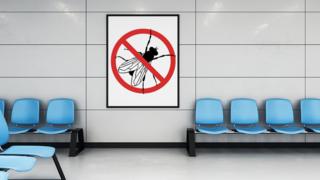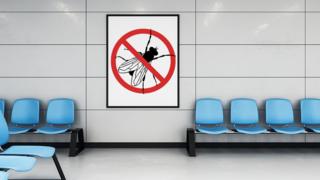Welsh hospitals: Pest control called for rats and ants
Rats and ants top the pest control issues experienced by hospitals, freedom of information requests reveal. …


Droppings in an operating theatre, flies in a labour ward and a false widow spider are among the reasons pest control services were called to Welsh hospitals over the past five years.
Ants and rats prompted the most call-outs but cockroaches, wasps, slugs and maggots were also spotted.
One health board spent almost £94,000 on pest control services over the period.
Costs varied and were only disclosed by some health boards.
Of those that did provide responses to Freedom of Information requests, Cwm Taf Morgannwg paid the most – £93,987 over five years, calling contractors out more than 200 times to deal with ants.
The board said its costs rose due to an increase in the number of sites it manages and charges.
A spokeswoman said: “As a health board, we are continually improving our facilities and there are ongoing building works on several of our sites… we have been developing more and more of our green spaces to support biodiversity and wildlife.
“This brings the challenge of tackling pests that naturally take advantage of this habitat.
“A change in weather patterns has also had an impact due to climatic changes, for example, hot and dry weather.”
The Cwm Taf hospital which received the most call-outs was Royal Glamorgan – more than 130 – where there were droppings spotted in a theatre, fleas in the medical records, flies in a labour ward and rats in a play area.
In 2016, it called out pest control services to deal with a false widow spider spotted on the hospital grounds.
Cwm Taf’s total number of call-outs rose from 59 in 2014 to 95 in 2018, with the health board not providing data for 2019. It requested 340 visits between 2014 and 2018.
Cardiff and Vale changed the way its data was stored in 2017, but said in 2018 it called services 36 times to deal with issues at Llandough Hospital in Penarth, including rats, ants, wasps, cockroaches and flies.
In Powys, call-outs rose each year, from just 16 in 2015 to 78 in 2019 – 166 times in total over that period – at a cost of £41,216.
Reasons included mice, rats, ants, flies, fleas and wasps.
A spokesman for the health board said its contract with a pest control company “is supplemented by an arrangement for call outs when a specific pest control problem arises, for example if the need to destroy a wasp nest is identified”.
He added: “We act promptly so that pest control concerns are addressed at the earliest opportunity and do not pose a significant risk.
“The pest control issues that arise within the Health Board reflect the rural setting of our hospitals and services; for example, conditions in summer 2019 gave rise to a higher number of call outs for the control of wasps when compared to previous years.”
In north Wales, services were called out 453 times between 2014 and March 2019, with Wrexham Maelor hospital receiving the overwhelming majority, for issues including wasps, ants, rats, maggots, slugs, silverfish, seagulls and pigeons.
The number of call-outs requested by the health board there, Betsi Cadwaladr, rose from 31 in 2014 to 110 in 2018 (with the 2019 figure, 34, only including calls made up to March).
And Swansea Bay said it did not record the number of call-outs due to its contract including eight preventative visits per year – which it said gave a “proactive approach” – and extra pest control visits when necessary. Since 2014 it has spent £52,249.
Hywel Dda Health Board has not provided any data, saying it still intends to respond to the request for information but has been under-resourced due to unforeseen circumstances. Aneurin Bevan does not hold any central record of the data.
What do the pest experts say?
Paul Blackhurst from Rentokill, which is contracted by many Welsh health boards, said pests will typically be drawn to the hospital’s warm and dry environment where there is food and shelter.
“It is likely that similar weather conditions experienced this summer could have caused increased rodent sightings, as well as encouraging the animals to search for water close to human habitation when their usual sources had dried up.”
He added there are steps the healthcare industry can take – including effective daily cleaning and ensuring waste is properly disposed of – which he said can be “a very challenging task” when dealing with vast areas and patients and staff passing through.
“Finally, many hospitals are based in older buildings, so facilities managers must ensure that the hospital building structures are well maintained in order to keep pests out,” he said.

